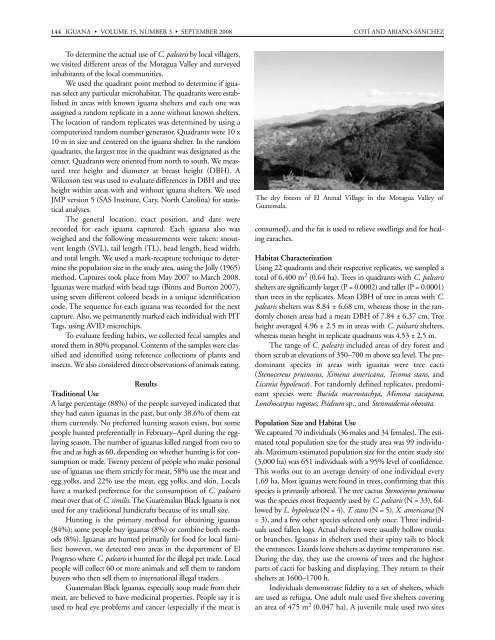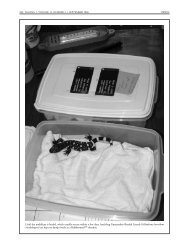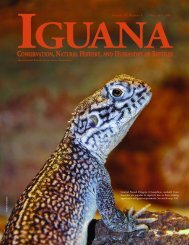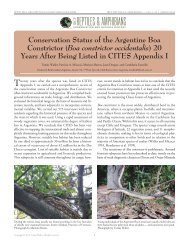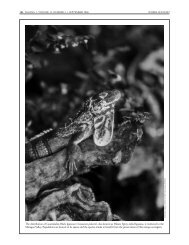Spiny-tailed Iguanas (Ctenosaura similis) in Venezuela
Spiny-tailed Iguanas (Ctenosaura similis) in Venezuela
Spiny-tailed Iguanas (Ctenosaura similis) in Venezuela
Create successful ePaper yourself
Turn your PDF publications into a flip-book with our unique Google optimized e-Paper software.
144 IGUANA • VOLUME 15, NUMBER 3 • SEPTEMBER 2008 COTÍ AND ARIANO-SÁNCHEZ<br />
To determ<strong>in</strong>e the actual use of C. palearis by local villagers,<br />
we visited different areas of the Motagua Valley and surveyed<br />
<strong>in</strong>habitants of the local communities.<br />
We used the quadrant po<strong>in</strong>t method to determ<strong>in</strong>e if iguanas<br />
select any particular microhabitat. The quadrants were established<br />
<strong>in</strong> areas with known iguana shelters and each one was<br />
assigned a random replicate <strong>in</strong> a zone without known shelters.<br />
The location of random replicates was determ<strong>in</strong>ed by us<strong>in</strong>g a<br />
computerized random number generator. Quadrants were 10 x<br />
10 m <strong>in</strong> size and centered on the iguana shelter. In the random<br />
quadrants, the largest tree <strong>in</strong> the quadrant was designated as the<br />
center. Quadrants were oriented from north to south. We measured<br />
tree height and diameter at breast height (DBH). A<br />
Wilcoxon test was used to evaluate differences <strong>in</strong> DBH and tree<br />
height with<strong>in</strong> areas with and without iguana shelters. We used<br />
JMP version 5 (SAS Institute, Cary, North Carol<strong>in</strong>a) for statistical<br />
analyses.<br />
The general location, exact position, and date were<br />
recorded for each iguana captured. Each iguana also was<br />
weighed and the follow<strong>in</strong>g measurements were taken: snoutvent<br />
length (SVL), tail length (TL), head length, head width,<br />
and total length. We used a mark-recapture technique to determ<strong>in</strong>e<br />
the population size <strong>in</strong> the study area, us<strong>in</strong>g the Jolly (1965)<br />
method. Captures took place from May 2007 to March 2008.<br />
<strong>Iguanas</strong> were marked with bead tags (B<strong>in</strong>ns and Burton 2007),<br />
us<strong>in</strong>g seven different colored beads <strong>in</strong> a unique identification<br />
code. The sequence for each iguana was recorded for the next<br />
capture. Also, we permanently marked each <strong>in</strong>dividual with PIT<br />
Tags, us<strong>in</strong>g AVID microchips.<br />
To evaluate feed<strong>in</strong>g habits, we collected fecal samples and<br />
stored them <strong>in</strong> 80% propanol. Contents of the samples were classified<br />
and identified us<strong>in</strong>g reference collections of plants and<br />
<strong>in</strong>sects. We also considered direct observations of animals eat<strong>in</strong>g.<br />
Results<br />
Traditional Use<br />
A large percentage (88%) of the people surveyed <strong>in</strong>dicated that<br />
they had eaten iguanas <strong>in</strong> the past, but only 38.6% of them eat<br />
them currently. No preferred hunt<strong>in</strong>g season exists, but some<br />
people hunted preferentially <strong>in</strong> February–April dur<strong>in</strong>g the egglay<strong>in</strong>g<br />
season. The number of iguanas killed ranged from two to<br />
five and as high as 60, depend<strong>in</strong>g on whether hunt<strong>in</strong>g is for consumption<br />
or trade. Twenty percent of people who make personal<br />
use of iguanas use them strictly for meat, 58% use the meat and<br />
egg yolks, and 22% use the meat, egg yolks, and sk<strong>in</strong>. Locals<br />
have a marked preference for the consumption of C. palearis<br />
meat over that of C. <strong>similis</strong>. The Guatemalan Black Iguana is not<br />
used for any traditional handicrafts because of its small size.<br />
Hunt<strong>in</strong>g is the primary method for obta<strong>in</strong><strong>in</strong>g iguanas<br />
(84%); some people buy iguanas (8%) or comb<strong>in</strong>e both methods<br />
(8%). <strong>Iguanas</strong> are hunted primarily for food for local families;<br />
however, we detected two areas <strong>in</strong> the department of El<br />
Progreso where C. palearis is hunted for the illegal pet trade. Local<br />
people will collect 60 or more animals and sell them to random<br />
buyers who then sell them to <strong>in</strong>ternational illegal traders.<br />
Guatemalan Black <strong>Iguanas</strong>, especially soup made from their<br />
meat, are believed to have medic<strong>in</strong>al properties. People say it is<br />
used to heal eye problems and cancer (especially if the meat is<br />
The dry forests of El Arenal Village <strong>in</strong> the Motagua Valley of<br />
Guatemala.<br />
consumed), and the fat is used to relieve swell<strong>in</strong>gs and for heal<strong>in</strong>g<br />
earaches.<br />
Habitat Characterization<br />
Us<strong>in</strong>g 22 quadrants and their respective replicates, we sampled a<br />
total of 6,400 m 2 (0.64 ha). Trees <strong>in</strong> quadrants with C. palearis<br />
shelters are significantly larger (P = 0.0002) and taller (P = 0.0001)<br />
than trees <strong>in</strong> the replicates. Mean DBH of tree <strong>in</strong> areas with C.<br />
palearis shelters was 8.84 ± 6.68 cm, whereas those <strong>in</strong> the randomly<br />
chosen areas had a mean DBH of 7.84 ± 6.37 cm. Tree<br />
height averaged 4.96 ± 2.5 m <strong>in</strong> areas with C. palearis shelters,<br />
whereas mean height <strong>in</strong> replicate quadrants was 4.53 ± 2.5 m.<br />
The range of C. palearis <strong>in</strong>cluded areas of dry forest and<br />
thorn scrub at elevations of 350–700 m above sea level. The predom<strong>in</strong>ant<br />
species <strong>in</strong> areas with iguanas were tree cacti<br />
(Stenocereus pru<strong>in</strong>osus, Ximena americana, Tecoma stans, and<br />
Licania hypoleuca). For randomly def<strong>in</strong>ed replicates, predom<strong>in</strong>ant<br />
species were Bucida macrostachya, Mimosa zacapana,<br />
Lonchocarpus rugosus, Psidium sp., and Stenmadenia obovata.<br />
Population Size and Habitat Use<br />
We captured 70 <strong>in</strong>dividuals (36 males and 34 females). The estimated<br />
total population size for the study area was 99 <strong>in</strong>dividuals.<br />
Maximum estimated population size for the entire study site<br />
(3,000 ha) was 651 <strong>in</strong>dividuals with a 95% level of confidence.<br />
This works out to an average density of one <strong>in</strong>dividual every<br />
1.69 ha. Most iguanas were found <strong>in</strong> trees, confirm<strong>in</strong>g that this<br />
species is primarily arboreal. The tree cactus Stenocereus pru<strong>in</strong>osus<br />
was the species most frequently used by C. palearis (N = 33), followed<br />
by L. hypoleuca (N = 4), T. stans (N = 5), X. americana (N<br />
= 3), and a few other species selected only once. Three <strong>in</strong>dividuals<br />
used fallen logs. Actual shelters were usually hollow trunks<br />
or branches. <strong>Iguanas</strong> <strong>in</strong> shelters used their sp<strong>in</strong>y tails to block<br />
the entrances. Lizards leave shelters as daytime temperatures rise.<br />
Dur<strong>in</strong>g the day, they use the crowns of trees and the highest<br />
parts of cacti for bask<strong>in</strong>g and display<strong>in</strong>g. They return to their<br />
shelters at 1600–1700 h.<br />
Individuals demonstrate fidelity to a set of shelters, which<br />
are used as refugia. One adult male used five shelters cover<strong>in</strong>g<br />
an area of 475 m 2 (0.047 ha). A juvenile male used two sites


